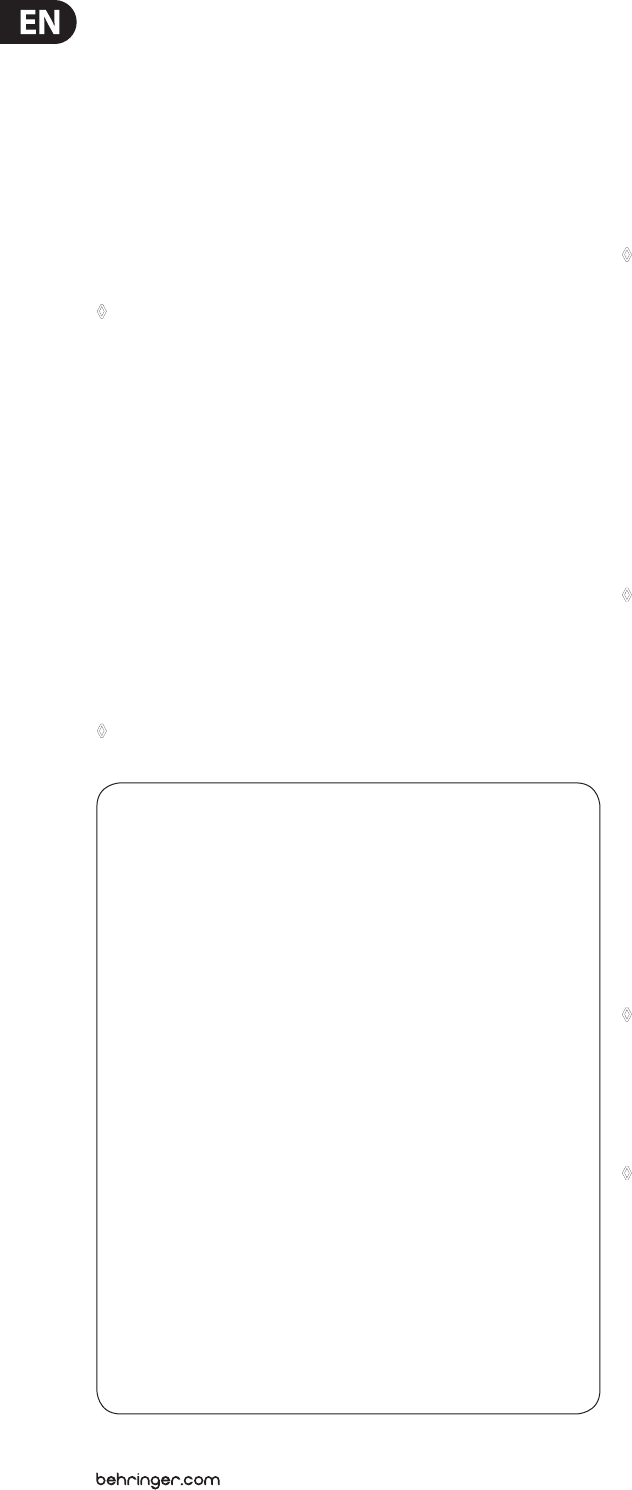
16 U-CONTROL UMA25S User Manual
Control changes5.5.2
The Control Change messages (CC) belong to the most “powerful” MIDI messages.
They allow you to control plenty of parameters and functions. You can assign CC
messages to each control element on the UMA25S. Since it is possible to use push
buttons, sliders and rotary knobs, the controller values can be controlled either
statically or dynamically in real time. A list of the assigned standard controller
numbers are found in Table A.1 of the supplementary sheet.
The Controller message consists of a controller number and the included
controller values. The E11 rotary knob is used to determine the controller number.
Continuous elements allow you to dene the value range with the E12
(minimum value) and E13 (maximum value) rotary knobs.
Alternatively, you can invert the value scale by assigning 127 as the ◊
minimum value and 0 as the maximum value (scale inversion). A classic
application of scale inversion is the drawbar control of virtual or digital
organs or organ expanders. In this manner, assign the controller 07
(volume) to a fader on the UMA25S and pulling up the fader attenuates
the signal. On the other hand, moving down the fader corresponds to
moving out the drawbars which increases the volume level.
Switch elements allow you to send dierent values when pressing and
releasing the push buttons (use the E12 and E13 rotary knobs to adjust). This is a
useful function when sending xed parameter settings. The switch behavior is
adjusted with E14, and the step interval for the Increment function is adjusted
with E15.
CC messages triggered by keys:
In case you want to assign CC messages to push buttons, but all switch elements
have already been assigned otherwise, you can use the keys on the keyboard.
For more information, read Chapter 5.5.9.
Table A.2 on the supplementary sheet gives you an overview of the ◊
rotary knob assignment in Edit Mode.
NRPN5.5.3
Apart from the CC messages, there are other controllers that don’t have a
standardized assignment and can be assigned variably from unit to unit.
These controllers are called NRPN (Non-Registered Parameter Number).
An NRPN is used when none of the standardized 127 controller numbers have the
necessary function.
Select the parameter number using the E11 rotary knob (see Table 7.3 in the
appendix). Just like the CC messages, the value range can be adjusted with the
E12 (minimum value) and E13 (maximum value) rotary knobs (see Chapter 5.5.4).
Table A.3 on the supplementary sheet gives you an overview of the ◊
rotary knob assignment in Edit Mode.
Note messages5.5.4
Playing notes on the keyboard:
For keyboard virtuosos, Note messages belong to the essential MIDI messages.
Thanks to them, the UMA25S can be used to play external sound modules and
virtual instruments. The value range for Note messages consists of 128 (0 – 127)
note numbers. Although the UMA25S only has 25 keys, the entire keyboard range
is covered using the Octave function. The velocity corresponds to the volume level
of a velocity-sensitive (piano) keyboard. Even though the Note O message is not
used that much anymore by keyboardists, the U-CONTROL is able to transmit this
status byte.
To play the keyboard, no assignment in Edit Mode is required. ◊
However, you have the possibility to send Note messages with the push
buttons (switch elements) and to specify the pitch of the keys.
Triggering Note messages using push buttons
(switch elements):
The UMA25S is able to send Note messages from the push buttons or the
footswitch in order to trigger drum loops and single sounds from a sampler,
for example. Many eects units allow you to tap delay times or song tempos
using Note messages. Since the push buttons are not velocity sensitive,
the transmitted velocity information is a x value in this case, which is adjusted
with E12.
The Note number is specied using the E11 rotary knob. The Note C3 (middle C)
corresponds to the MIDI note value 60 (see also Table 7.2). The E12 rotary knob
allows you to adjust the velocity. E14 lets you specify the switch behavior
(Toggle On/O). Turn E15 to discard the settings and return to the standard
keyboard assignment (reset function; display shows “reS”).
It is not possible to assign Note messages to continuous ◊
control elements.
Free assignment of Note messages to keys:
This function allows you to specify the pitch of each key on the keyboard.
For more information, read Chapter 5.5.9.
Table A.4 on the supplementary sheet gives you an overview of the ◊
rotary knob assignment in Edit Mode.
Examples of assigning controllers
(CC, NRPN, GS/XG):
You want to use the E9 rotary knob to adjust the resonance frequency of
a virtual analog synthesizer in real time. Follow the steps below:
Press and hold down the EDIT/EXIT push button and turn the E9 1.
rotary knob. As soon as E09 appears on the display, release the
EDIT/EXIT push button.
Select the desired type of MIDI message (CC, NRPN, GS/XG) 2.
by using E9.
Use E10 to select the MIDI channel on which your instrument is 3.
ready to receive.
Select the controller number (or the controller name for GS/XG) 4.
by using E11. If the MIDI implementation of your instrument
follows the standard assignment, this should be number 74.
Turn E12 completely to the left and E13 completely to the right in 5.
order not to limit the control range of 0 to 127.
If a value is to show on the display when using a rotary knob, 6.
select “ON” with E16.
Press the ENTER key to conrm.7.
Result: By turning the E9 rotary knob, you can change the
resonance frequency of the instrument in real time.


















